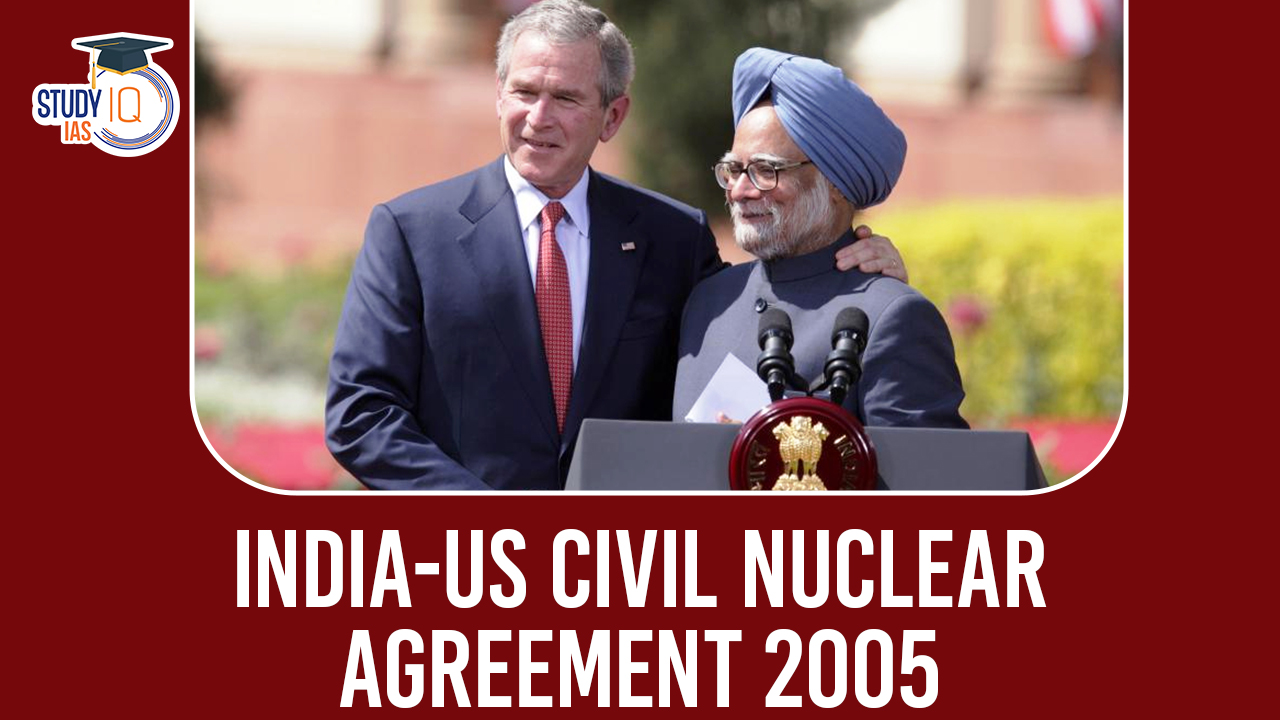Table of Contents
The India-US Civil Nuclear Agreement 2005, also known as the 123 Agreement, is a landmark bilateral nuclear cooperation agreement between the United States and India. It was signed in 2005 and went into effect in 2008. The agreement was a significant departure from previous U.S. policy, which had largely restricted nuclear cooperation with countries without the Nuclear Non-Proliferation Treaty (NPT).
We’re now on WhatsApp. Click to Join
India-US Civil Nuclear Agreement 2005 Overview
The India-US Civil Nuclear Agreement, often referred to as the 123 Agreement, was a pivotal deal between the United States and India that was reached in 2005. This agreement aimed to facilitate civilian nuclear cooperation between the two countries, but it had several significant implications and conditions.
| Aspect | Description |
| Background | India’s nuclear isolation is due to its weapons program. |
| Purpose | Facilitate civilian nuclear cooperation between India and the U.S. to meet India’s energy needs. |
| Key Provisions | – Separation of civilian and military facilities. – Civilian nuclear technology and fuel access for India. – Establishment of a U.S.-India Nuclear Suppliers Group. |
| U.S. Congress Approval | Legislation passed in December 2006 to amend U.S. nuclear export laws. |
| International Reaction | Mixed reactions, and concerns about the NPT’s principles. |
| NSG Waiver | Granted in September 2008, it allowed India to engage in nuclear trade. |
| Implementation | Challenges addressed, substantial progress by 2010. |
| Long-Term Impact | Strengthened U.S.-India ties, implications for global nuclear policy. |
India-US Civil Nuclear Agreement 2005 Background
The India-US Civil Nuclear Agreement of 2005 emerged against the backdrop of India’s nuclear isolation, stemming from its weapons program and non-signatory status to the Nuclear Non-Proliferation Treaty. India’s rapidly growing energy demands, coupled with its limited domestic resources, prompted its quest for civilian nuclear technology. The George W. Bush administration sought to enhance relations with India, recognizing its strategic importance. Negotiations resulted in the 123 Agreement, which aimed to balance India’s access to civilian nuclear technology with non-proliferation concerns, marking a pivotal shift in international nuclear policy and fostering a deeper U.S.-India partnership.
India-US Civil Nuclear Agreement 2005 Objectives
The India-US Civil Nuclear Agreement of 2005 had several key objectives:
- Energy Security: To help India meet its growing energy demands and reduce its reliance on fossil fuels by facilitating access to nuclear technology and fuel for civilian energy production.
- Strategic Partnership: To strengthen the strategic partnership between India and the United States by fostering cooperation in the field of nuclear energy.
- Non-Proliferation: To bring India into the global non-proliferation regime by separating its civilian and military nuclear facilities and placing the former under International Atomic Energy Agency (IAEA) safeguards.
- Economic Opportunities: To create economic opportunities for U.S. businesses by allowing them to engage in civilian nuclear trade with India.
- Global Nuclear Policy: To influence global nuclear policy by making exceptions for India, a non-NPT signatory, and addressing the challenge of balancing non-proliferation objectives with energy cooperation.
India-US Civil Nuclear Agreement 2005 Features
Key features of the India-US Civil Nuclear Agreement (123 Agreement) of 2005:
Civilian-Military Facility Separation
- India agreed to separate its civilian and military nuclear facilities. This was a critical non-proliferation measure designed to ensure that only civilian nuclear facilities would be open to international scrutiny.
- Civilian facilities were to be placed under International Atomic Energy Agency (IAEA) safeguards, meaning they would be subject to inspections and oversight by the IAEA to verify their peaceful use.
Access to Civilian Nuclear Technology
- One of the primary features of the agreement was that it allowed India access to civilian nuclear technology, equipment, and fuel from the international market. This access was previously restricted due to India’s status as a non-signatory to the Nuclear Non-Proliferation Treaty (NPT).
- India could import nuclear reactors, fuel, and other technology to expand its civilian nuclear energy program, thus addressing its growing energy demands.
Change in U.S. Policy
- The United States had to make significant changes to its domestic laws and policies to enable civilian nuclear trade with India. The U.S. Congress passed legislation, including the Hyde Act and the 123 Agreement, to amend existing nuclear export laws.
- These changes marked a substantial departure from the traditional U.S. non-proliferation policy that had restricted nuclear cooperation with countries that were not part of the NPT.
Nuclear Suppliers Group (NSG) Waiver
- In 2008, the NSG granted a special waiver to India, allowing it to participate in civilian nuclear trade despite its non-NPT status. This waiver was crucial for the implementation of the agreement.
- The NSG waiver represented an international acceptance of the agreement and demonstrated that the international community was willing to make exceptions for India.
Strategic and Economic Implications
- The agreement had significant strategic implications for the U.S.-India relationship. It helped strengthen the strategic partnership between the two countries by fostering cooperation in the field of nuclear energy.
- Additionally, the agreement offered economic opportunities for U.S. businesses in the nuclear sector, as they gained access to the Indian nuclear market.
Global Non-Proliferation Impact
- The agreement sparked debates and discussions about its impact on global nuclear non-proliferation norms. Critics argued that making exceptions for India, a non-NPT signatory with nuclear weapons, set a precedent that could undermine the NPT’s principles.
- Supporters contended that the agreement was an exceptional case and that it represented a balance between addressing India’s energy needs and maintaining non-proliferation efforts.
India-US Civil Nuclear Agreement 2005 Importance
The India-US Civil Nuclear Agreement of 2005 held immense significance for various reasons:
- Strategic Partnership: It deepened the strategic partnership between the U.S. and India, recognizing India’s role as a key ally in the region.
- Energy Security: It helped India meet its surging energy demands, reducing its reliance on fossil fuels, and addressing its power needs through nuclear energy.
- Non-Proliferation Balance: The agreement posed a challenge by making exceptions for India, a non-NPT signatory, raising questions about the balance between energy cooperation and non-proliferation.
- Economic Opportunities: It opened economic opportunities for U.S. nuclear companies by enabling them to engage in nuclear trade with India.
- Global Nuclear Policy: The agreement influenced global nuclear policy discussions regarding non-proliferation and civilian nuclear cooperation.
India-US Civil Nuclear Agreement 2005 UPSC
The India-US Civil Nuclear Agreement of 2005, often referred to as the 123 Agreement, marked a pivotal moment in international relations. It allowed India, a non-Nuclear Non-Proliferation Treaty (NPT) signatory, access to civilian nuclear technology and equipment while requiring the separation of its civilian and military nuclear facilities under International Atomic Energy Agency (IAEA) safeguards. This landmark deal had profound implications, strengthening the strategic partnership between the U.S. and India and addressing India’s energy needs. However, it stirred a global debate on the balance between energy cooperation and non-proliferation, and it remains a significant case study in international diplomacy and nuclear policy.


 Comprehensive Remote Sensing Observation...
Comprehensive Remote Sensing Observation...
 Perovskite Solar Cells, Objective and Ch...
Perovskite Solar Cells, Objective and Ch...
 Navy-Marine Expeditionary Ship Interdict...
Navy-Marine Expeditionary Ship Interdict...





















